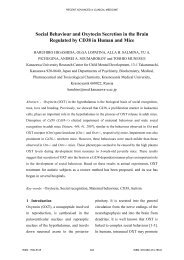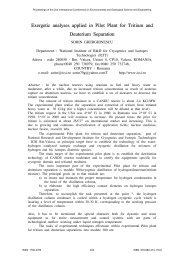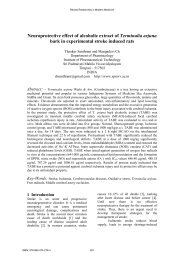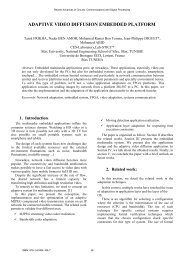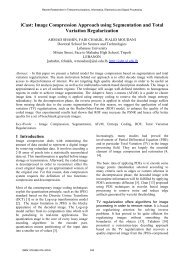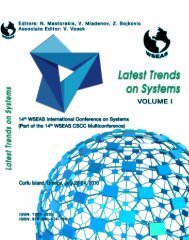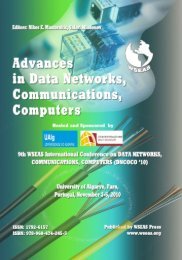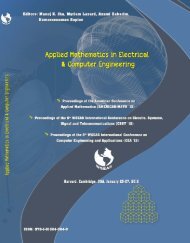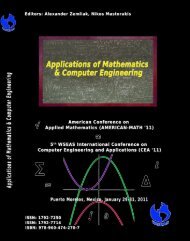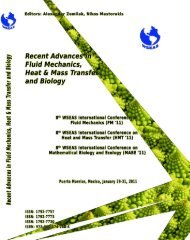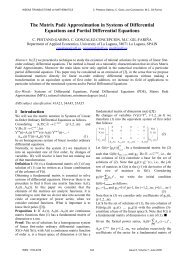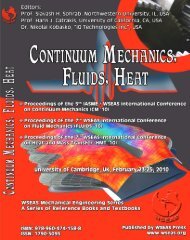Mathematical methods and - Wseas.us
Mathematical methods and - Wseas.us
Mathematical methods and - Wseas.us
You also want an ePaper? Increase the reach of your titles
YUMPU automatically turns print PDFs into web optimized ePapers that Google loves.
MATHEMATICAL METHODS AND APPLIED COMPUTINGPlenary Lecture 5Potential Method in the Performance Evaluation of a Network NodeAssistant Professor Andrzej ChydzinskiInstitute of Computer SciencesSilesian University of Technology, GliwicePol<strong>and</strong>E-mail: <strong>and</strong>rzej.chydzinski@gmail.comAbstract: The advantages of packet-switching networking over circuit switching made the packet-switchingtechnology very successful (e.g. Internet). However, the cost of packet switching is that in each network node,packets are queued, resulting in delay <strong>and</strong> packet losses during buffer overflow periods. The queues in networknodes <strong>us</strong>ed to be modeled by a classic FIFO queue with Poisson arrivals. Since the beginning of 90's we have knownthat traffic in packet-switching networks is strongly autocorrelated <strong>and</strong> therefore we have to <strong>us</strong>e much more advancedmodels for it. Markovian models like MMPP, MAP <strong>and</strong> BMAP were adopted for this purpose with good results. On theother h<strong>and</strong>, when modeling a queue in a network node, it is important that the finite size of the buffer is assumed, asfinite buffer is responsible for packet losses.The subject of this lecture is the performance analysis of a finite-buffer queue fed by Markovian arrival process. Thelecture is particularly foc<strong>us</strong>ed on a relatively new method of analysis of such queues - so called "potential method". Atfirst, the method <strong>us</strong>es the Laplace transform technique in order to reduce a large system of integral equations to asystem of linear equations. Then, with the help of a recurrent sequence called "potential", the large system is solved<strong>and</strong> the results are obtained in an explicit form. The method has some important advantages. It enables findingalmost all queueing characteristics of interest. It gives results in a closed, easy to <strong>us</strong>e form <strong>and</strong> this is a uniqueproperty among <strong>methods</strong> of analysis of finite-buffer queues. Moreover, both steady-state <strong>and</strong> transient performancecharacteristics can be obtained by means of the method.Brief Biography of the Speaker:Andrzej Chydzinski received his MSc (in applied mathematics), PhD (in computer science) <strong>and</strong> Habilitation (incomputer science) degrees from the Silesian University of Technology, Gliwice, Pol<strong>and</strong>, in 1997, 2002 <strong>and</strong> 2008,respectively. He is currently an Assistant Professor in the Institute of Computer Sciences of this university. Hisacademic <strong>and</strong> professional interests include modeling <strong>and</strong> simulation of computer networks, active queuemanagement in Internet routers, queueing theory <strong>and</strong> discrete-event network simulators. Dr. Chydzinski authored <strong>and</strong>co-authored more than fifty journal <strong>and</strong> conference papers <strong>and</strong> two books. His work is well recognized - ThomsonScientific reports that his publications were cited about 100 times (excluding self-citations) in ISI indexed journals. Hewas also awarded for his work by a major Polish magazine <strong>and</strong> was given (with R. Winiarczyk) the best paper awardin modeling <strong>and</strong> simulation during the IEEE Symposium on Computers <strong>and</strong> Communications in 2006. He has beeninvolved in several scientific projects, in some of them as a project leader.ISSN: 1790-2769 24 ISBN: 978-960-474-124-3




